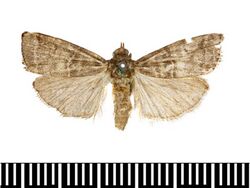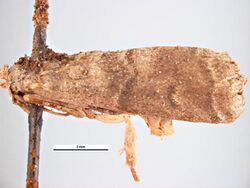Biology:Acrobasis pirivorella
| Acrobasis pirivorella | |
|---|---|

| |

| |
| Scientific classification | |
| Domain: | Eukaryota |
| Kingdom: | Animalia |
| Phylum: | Arthropoda |
| Class: | Insecta |
| Order: | Lepidoptera |
| Family: | Pyralidae |
| Genus: | Acrobasis |
| Species: | A. pirivorella
|
| Binomial name | |
| Acrobasis pirivorella (Matsumura, 1900)
| |
| Synonyms | |
| |
Acrobasis pyrivorella, the pear fruit moth, pear moth or pear pyralid, is a moth of the family Pyralidae. It is native to the temperate zone of eastern Asia, where it is widely distributed. It has been recorded from northern China , the Korean Peninsula, Japan , Taiwan and Russia (Primor'ye and Khabarovskii provinces).
The wingspan is 14.5–21.5 mm. Adults are greyish with a violet tinge. The forewings have two transverse stripes with a crescent-shaped dark apical spot in between. The hindwings are yellowish-grey. In Russia, adults are on wing from mid July to mid-August and again in September. The first generation adults bore into the bud and go into hibernation.[1]
The larvae feed on wild and cultivated forms of pears. It either overwinters as first-instar or second-instar larva in the flower buds of pears in a thin white cocoon. In spring the larva moves to a fresh bud and feed in the developing buds, flowers and fruitlets. The larvae may move from fruit to fruit. The larva makes a hole in each fruit and pupate in the fruit, usually at the end of May. The larvae are rose-pink in the first instar, while full-grown larvae are dark-green dorsally and pale-yellow ventrally.
References
Wikidata ☰ Q4675255 entry
 |

